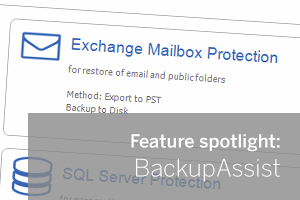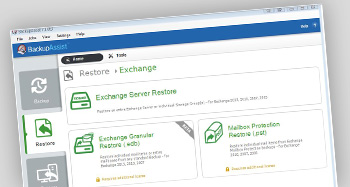Since the introduction of Microsoft’s Volume Shadow Copy Service in Server 2003 it is common to backup the Exchange database in its entirety as part of a bare-metal backup job. This is a great way to deal with a disaster such as a hard drive failure where you want to recover a whole server, or even if you need to recover the whole Exchange database back to a point in time. The difficulty comes when you want to recover, for example just a single mailbox, or even specific emails. With a full backup, you are backing up the entire database which means you’ll need to recover the full database first to a temporary location, mount this as a recovery database, connect to it with a client and then extract the data. With a large database this could take quite a lot of time and resources to complete.
BackupAssist has a much easier, more convenient way.
 Following on from Part 1 of this guide where I explained how to create Exchange Granular Restore ("EGR") compatible backups in BackupAssist, in this second instalment I will look in more detail at how we can restore email from within the backups we have created.
Following on from Part 1 of this guide where I explained how to create Exchange Granular Restore ("EGR") compatible backups in BackupAssist, in this second instalment I will look in more detail at how we can restore email from within the backups we have created.


 The release of BackupAssist v7.1 is only a few days away now so I thought it would be the perfect time to introduce one of the great new features, the 'Exchange Granular Restore Console'.
The release of BackupAssist v7.1 is only a few days away now so I thought it would be the perfect time to introduce one of the great new features, the 'Exchange Granular Restore Console'.
 I had an interesting support request recently where a customer asked if there was a way to archive a particular user's mail folders in slightly different ways to all the other users.
I had an interesting support request recently where a customer asked if there was a way to archive a particular user's mail folders in slightly different ways to all the other users.